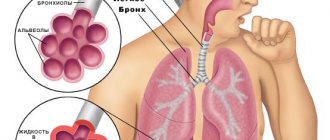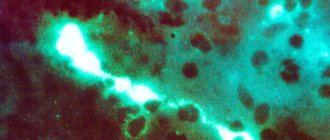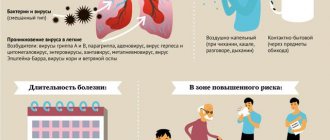Pneumonia is an acute infectious disease in which an inflammatory process occurs in the lung tissue. All conditions have been created for the treatment of pneumonia at the Yusupov Hospital. Patients with mild or moderate severity are admitted to the therapy clinic. In severe cases of pneumonia, patients are treated in the intensive care unit.
Doctors use modern diagnostic methods and use the latest equipment from leading American, Japanese and European manufacturers. The use of innovative laboratory diagnostic techniques makes it possible to determine the severity of pneumonia and changes in other organs and systems caused by the pathological process. Pulmonologists prescribe effective drugs that have a minimal range of side effects.
Doctors treat each patient individually. Severe cases of pneumonia are discussed at a meeting of the Expert Council with the participation of professors and doctors of the highest category. If indicated, patients are given artificial ventilation using stationary or portable expert-class devices.
General information about the disease
When a child gets sick with ARVI, a lot of mucus is produced in his bronchi. It tends to accumulate, especially in preschoolers, because their chest muscles are not yet developed enough for effective coughing. As a result, some areas of the lungs are deprived of ventilation and become vulnerable to pathogens. Viruses and bacteria settle in them, causing inflammation. In the viral form, the disease goes away in about 5-6 days without treatment, and if it is caused by bacteria, then special therapy is required.
Attention! Treatment must be precisely targeted to the pathogen; individual selection of the drug and dosage is necessary. Self-medication can lead to irreversible consequences.
Pneumonia can occur even in a newborn; it is of aspiration origin in this case, that is, the cause is the baby swallowing amniotic fluid during childbirth.
The disease has an excellent prognosis if treatment is started on time. Complicated cases requiring hospital treatment with intravenous drugs are only 8-10%.
Causes of pneumonia in childhood
- improper therapy for ARVI, self-medication;
- complication of other respiratory diseases;
- infections (in exceptional and very rare cases, a bacterial disease can be contagious);
- weak immunity as a factor that expands the number of causes of pneumonia - even injury.
The nature of the disease may even be toxicological. The mechanism of our body’s work is such that with a huge number of ailments, harmful, toxic – “garbage” – substances filtered by the circulatory system settle in the lungs. Due to this, “weak” areas and local blockages are formed. Infections, viruses, and inflammation then develop in them. Even ailments not directly related to the respiratory system often lead to pneumonia.
Principles of treatment
When pneumonia is diagnosed in a newborn, treatment should begin as soon as possible. The prognosis for recovery directly depends on how quickly treatment is started. Treatment of pneumonia in newborns is complex and includes the following measures:
- taking antibiotics - in the first case, a broad-spectrum drug is prescribed; after receiving the results of blood biochemistry, the antibiotic can be replaced with another. Intramuscular administration of the drug is more effective. The lack of relief after 2 days indicates the wrong choice of antibiotic. For infants, preference is given to drugs of the penicillin group. However, it is worth noting that infection with pneumonia in a maternity hospital is most difficult to treat due to the extreme resistance of the pathogen to drugs;
- taking medications aimed at restoring intestinal microflora in order to prevent the development of dysbacteriosis;
- immunomodulators and vitamin complexes are prescribed as maintenance drugs after the main treatment;
- intravenous infusions of saline are prescribed for severe forms of the disease to reduce intoxication of the body;
- mucolytics to improve sputum discharge;
- antipyretics provide virtually no relief; they are taken to control the rise in body temperature;
- chest massage using vibration method for better sputum discharge;
- physiotherapy is mainly represented by inhalations, it begins to be used after the acute form of the disease is removed;
- in cases of severe disease, hormonal drugs may be prescribed;
- in case of oxygen starvation, the use of an oxygen mask is recommended.
Treatment of pneumonia in a child using folk methods and recipes is unacceptable. During treatment, it is important to fully care for the little patient around the clock, give him food as often as possible, and avoid overheating and hypothermia. On average, treatment lasts 10-15 days.
Symptoms of the disease
- Shortness of breath, which occurs even at normal body temperature.
- Severe and prolonged cough.
- Lack of spontaneous recovery within 7 days.
- Deterioration of condition after short-term improvement.
- High body temperature, rapidly rising after attempts to reduce it.
- The child cannot take a deep breath, filling the lungs. Attempts to do this lead to an attack of suffocating cough.
- With the bacterial form of the disease, the skin becomes pale, sometimes almost bluish. If the child’s skin is of normal color, then most likely he has viral pneumonia, which is less dangerous. Source: T.A. Kovtun, A.V. Tutelyan, S.V. Shabalina Features of the course of pneumonia in children and principles of therapy Epidemiology and infectious diseases, 2012, No. 3, pp. 52-56
Complications
The consequences of pneumonia in newborns are quite serious, since the lack of prompt treatment leads to death. At the current level of development of medicine, the percentage of child mortality from pneumonia is 40%. If pneumonia is treated promptly, newborns have a favorable prognosis.
Consequences after pneumonia in newborns are almost always expressed in residual effects and pathologies. Among the complications from pneumonia in children are the following:
- prolonged lingering cough;
- otitis;
- meningitis is caused by the presence of the pathogen pneumococcus;
- pleurisy develops from damage to the pleura;
- pulmonary sepsis;
- chronic pneumonia is an untreated form of the disease in which every cold will lead to pneumonia;
- collapsed lung;
- bronchopulmonary dysplasia develops in premature babies;
- multiple organ failure;
- neurological defects appear in the presence of suffocation (asphyxia).
With pneumonia in a newborn, consequences in the form of complications more often appear in cases of delayed treatment, the child is premature or weak.
Remember, it is easier to prevent any disease or start treating it on time than to deal with complications later.
What types of pneumonia are there: classification
By localization:
- one-sided (one lung is affected);
- bilateral (both lungs are inflamed).
Based on its origin, pneumonia is divided into three types.
- Fungal (up to 5% of cases) is the rarest type of disease and the most dangerous. In childhood, it most often occurs against the background of improper and/or uncontrolled use of antibiotics.
- Bacterial (about 35% of cases) - occurs either separately or as a complication of a respiratory disease. Requires immediate medical attention for treatment with antibiotics.
- Viral (about 60% of patients) is a mild form of the disease, which in children goes away on its own in about a week, being cured by the body.
Main manifestations
Signs of pneumonia in a newborn:
- elevated body temperature. There are two possible course of the disease: a very high temperature that cannot be reduced, or a temperature of 37.5°C that lasts for a long time;
- a dry cough can torment the baby in attacks or last for more than 7 days;
- heavy breathing with signs of shortness of breath - it is impossible to take a deep breath due to pain in the chest;
- pallor of the skin - a blue nasolabial triangle or a bluish-grayish tint to the skin on the baby’s body;
- behavioral characteristics - lethargy and weakness, prolonged and frequent sleep or lack thereof, moodiness, loss of appetite and excruciating thirst.
When pneumonia occurs in an infant, the symptoms do not always have pronounced features; quite often, the first moments of the development of the disease occur asymptomatically. If the cause of pneumonia in newborns lies in prematurity, then this guarantees the course of the disease in a severe form.
With pneumonia in newborns, it is especially important to make a correct and prompt diagnosis, which will avoid serious consequences after pneumonia in newborns.
Seeing a doctor
At the slightest suspicion of pneumonia, you should contact your pediatrician to share your observations. The presence of signs of pneumonia in newborns is an indication for hospitalization. Because it is possible to conduct a full examination and make a competent and prompt diagnosis only in a hospital setting.
Treatment of pneumonia in infants is carried out only in a 24-hour hospital under the constant supervision of doctors. The child is in the hospital with his mother.
JSC “Medicine” (academician Roitberg’s clinic) employs highly qualified pediatricians with over 15 years of experience. Here, children's health is treated as the most important mission, so consultations are conducted by doctors of the highest category. They know almost everything about children's health and the specifics of diseases in children. Our clinic is located in the very center of Moscow.
Methods of diagnosis and early detection
Even if you find a complete list of symptoms of pneumonia in your child and are almost sure of its origin, you should definitely consult a doctor to clarify the diagnosis and further treatment. Experts use the following methods for detecting pneumonia:
- listening with a stethoscope (wheezing, characteristic “gurgling” may be heard in the lungs);
- collecting anamnesis, visual examination to assess the child’s condition as a whole, listening to complaints;
- X-ray of the chest in two projections - frontal and lateral. Only a frontal image may not be informative in some cases, because it contains a cardiac shadow, which can “cover” the inflamed area;
- clinical blood test (reveals the nature of the disease, in addition to its presence). Source: L.S. Namazova-Baranova, T.V. Kulichenko, A.E. Malakhova, E.V. Starovoitova, M.D. Bakradze, I.L. Chashchina, I.L. Mityushin Pneumococcal pneumonia in children: lessons from everyday practice // Issues of modern pediatrics, 2012, v. 11, no. 4, pp. 65-72
Diagnostics
Only a doctor can correctly diagnose pneumonia in newborns.
Diagnosis of pneumonia in infants is made using the following methods:
- examination of mucous membranes and skin, measurement of body temperature;
- listening to the lungs for the presence of wheezing and hardness of breathing;
- instrumental studies:
- a general blood test to check for increased ESR and leukocytes, indicating the presence of inflammation;
- blood biochemistry is carried out to determine the pathogen;
- sputum culture is carried out to determine the sensitivity of the pathogen to medications;
- X-rays show the inflamed areas and the extent of their damage.
How is pneumonia treated in children?
If the viral form of pneumonia goes away on its own, then treatment of fungal and bacterial forms requires specialist intervention and medications.
- Bacterial pneumonia is treated with antibiotics and only as prescribed by a doctor. Here it is worth addressing parents who do not accept these drugs: before the introduction of antibiotics, more than a third of children died due to pneumonia! Therefore, you should not focus on possible complications, which are minimized in modern drugs (and they are not prescribed in long courses), but focus on guaranteeing a complete cure.
- Pneumomycosis, or a fungal type of pneumonia, requires antifungal medications. Treatment should only be prescribed by a doctor, since this form of the disease is the most dangerous, and the medications are among the most complex.
Parents can additionally take measures such as:
- maintaining the child’s usual lifestyle (albeit on sick leave) whenever possible, because bed rest and low physical activity lead to stagnant processes in the respiratory system;
- providing plenty of fluids to thin mucus in the airways and lungs;
- the temperature in the child’s room should be no higher than 21 degrees, and the humidity should be about 70%, so that the mucus does not stagnate and it is easier for the child to breathe.
The role of antiviral therapy in pneumonia
It is known that inflammation of the respiratory tract is usually a complication caused by a viral or bacterial infection. Even an experienced doctor cannot determine whether pneumonia is viral or of another nature and make a final diagnosis regarding the cause of the disease during the first examination of a small patient. To do this, it is necessary to do a number of clinical and laboratory tests, for example, conduct a sputum, blood test, and take an X-ray of the lungs. All this takes time, which, as a rule, is not much. Therefore, most often the doctor is prompted to the viral nature of pneumonia by a characteristic sound when listening to the respiratory tract. Thus, doctors can rightfully prescribe antiviral drugs. Such drugs include Viferon Suppositories. It contains interferon protein, which prevents the proliferation of viruses, as well as vitamins C and E, which are antioxidants and contribute to the better functioning of interferon in the human body. Thanks to its dosage form (rectal suppositories), Viferon, when introduced into the patient’s rectum, begins to act very quickly, without creating additional stress on the baby’s digestive system. The drug is indicated for children from the first days of life, and even for premature babies. The use of the drug VIFERON® as part of complex therapy makes it possible to reduce therapeutic doses of antibacterial and hormonal drugs, as well as reduce the toxic effects of this therapy.
Methods for effective prevention
Proper prevention does not include drug therapy. To prevent the disease you need:
- vaccinate your child in a timely manner;
- provide hardening, introduce physical education;
- breastfeed the baby in the first six months of life;
- do not smoke near the child;
- purify the air in the apartment;
- Consult a doctor in a timely manner if signs of unwellness occur. Source: https://www.ncbi.nlm.nih.gov/pubmed/31518547 Nascimento-Carvalho CM Community-acquired pneumonia among children: the latest evidence for an updated management // J Pediatr ( Rio J). 2019 Sep 10. pii: S0021-7557(19)30493-0. doi: 10.1016/j.jped.2019.08.003
Should I give my child antibiotics to prevent pneumonia?
If you find signs of ARVI in a child, then you should not give him antibiotics in advance, “for prevention.” Especially if you are going to do it yourself or on the recommendation of a pharmacist from your nearest pharmacy. According to the latest data, this measure will not only fail, but will also increase the likelihood of pneumonia for your child by almost 10 times.
Antiviral drugs for pneumonia
Is it necessary to use antiviral drugs for pneumonia? More often, pneumonia has a mixed etiology; in other words, several pathogens can be present in the body at once: viruses, bacteria and sometimes even fungi. That is why doctors more often prescribe complex therapy, which includes both antibacterial and antiviral drugs. Of course, as with any other disease, self-medication and self-prescription of certain drugs is unacceptable, especially when it comes to the health of a child.
Advantages of SM-Clinic
The children's department of our medical center employs some of the best pediatricians, pulmonologists and other specialists in the Northern capital.
Make an appointment at the first sign of a respiratory disease or its complications - we will help quickly and effectively.
If a child has a severe form of pneumonia and requires hospitalization, we will offer a comfortable and cozy room. The patient will be monitored around the clock by responsible medical personnel, and effective therapy will be provided.
Sources:
- T.A. Kovtun, A.V. Tutelyan, S.V. Shabalina. Features of the course of pneumonia in children and principles of therapy // Epidemiology and infectious diseases, 2012, No. 3, pp. 52-56.
- L.S. Namazova-Baranova, T.V. Kulichenko, A.E. Malakhova, E.V. Starovoitova, M.D. Bakradze, I.L. Chashchina, I.L. Mityushin. Pneumococcal pneumonia in children: lessons from everyday practice // Issues of modern pediatrics, 2012, vol. 11, no. 4, pp. 65-72.
- https://www.ncbi.nlm.nih.gov/pubmed/31518547 Nascimento-Carvalho C.M. Community-acquired pneumonia among children: the latest evidence for an updated management // J Pediatr (Rio J). 2021 Sep 10. pii: S0021-7557(19)30493-0. doi: 10.1016/j.jped.2019.08.003.
Symptoms
Symptoms vary depending on the person's age and the cause of the pneumonia and may include:
- rapid breathing (in some cases this is the only symptom);
- wheezing breathing (audible to a doctor through a stethoscope, or even audible to strangers without a stethoscope);
- difficulty breathing: may be manifested by flaring of the nostrils, breathing using the abdominal muscles, retraction of the intercostal spaces and fear in the patient’s eyes;
- fever;
- cough;
- nasal congestion;
- trembling from chills;
- vomiting;
- chest pain;
- abdominal pain (muscular, as the abdominal muscles are involved in a strained cough or help with difficulty breathing);
- decreased activity;
- loss of appetite (in older children) or poor sucking (in infants), which can lead to dehydration;
- bluish or gray color of lips and nails (in severe cases).
If the source of pneumonia is located in the lower part of the lungs, closer to the abdomen, you may experience abdominal pain or vomiting, without problems breathing.
Prices
| Name of service (price list incomplete) | Price |
| Appointment (examination, consultation) with a pulmonologist, primary, therapeutic and diagnostic, outpatient | 1750 rub. |
| Consultation with a candidate of medical sciences | 2500 rub. |
| Professor consultation | 4500 rub. |
| Consultation (interpretation) with analyzes from third parties | 2250 rub. |
| Prescription of treatment regimen (for up to 1 month) | 1800 rub. |
| Study of external respiratory function (RPF) with drug tests | 1800 rub. |
| X-ray of the chest organs (survey) | 1900 rub. |
| X-ray of the chest organs in 2 projections | 2900 rub. |










